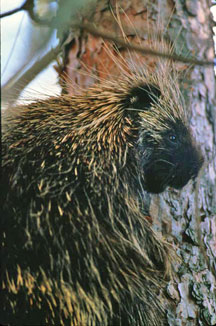 These nocturnal creatures weigh
15- 20 pounds. That’s one large rodent! |
Love is in the Air for Porcupines
October is the month of love for porcupines, a time of year when the solitary creatures briefly pair up. The male sings to the female with grunts, then the two rub noses and touch each others heads with their front paws. In March and April the female porcupine will have a single porcupette. Porcupettes are born with quills, but luckily for their mothers they don't harden until after they are born. A porcupette will stay with its mother for about 6 months before it heads off on its own.
Through the spring and summer the two will eat leaves, twigs, buds, flowers, and berries. In winter, they will eat the inner layer of bark and needles from coniferous trees. Porcupines also love salt and have been known to chew on things that humans have touched, like canoe paddles and axe handles.
In the winter porcupines sometimes den together in caves, hollow logs, stumps, or trees. Porcupines don't hibernate, but they also don’t travel very far from food trees during the colder months.
Did you know? A porcupine is covered with about 30,000 quills, but they can’t actually shoot them. The barbed quills get stuck in predators when they get too close and are swatted. A porcupine's most successful predator is the fisher, but coyotes, red foxes, and bobcats have also been known to catch them. With their excellent defenses, a porcupine's survival rate is good and they may live up to 10 years!
Learn more: Natureworks
|
